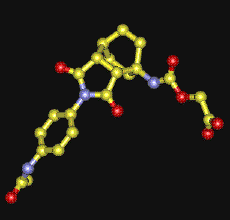 The resorcinol based aromatic molecule shown below forms hydrogen-bonded lattices in the
solid state, the cavities of which are large enough to accomodate three small organic molecules,
such as methyl methacrylate and cyclohexadiene. Click here
to see a 3D model of the cavity and the reagents trapped inside. Other types of cavities formed from covalently bound
porphyrinic-hosts (as opposed to cavities formed via intermolecular hydrogen bonds) have been synthesised by Jeremy Sanders at Cambridge. Calculated models
for these can be seen here.
The resorcinol based aromatic molecule shown below forms hydrogen-bonded lattices in the
solid state, the cavities of which are large enough to accomodate three small organic molecules,
such as methyl methacrylate and cyclohexadiene. Click here
to see a 3D model of the cavity and the reagents trapped inside. Other types of cavities formed from covalently bound
porphyrinic-hosts (as opposed to cavities formed via intermolecular hydrogen bonds) have been synthesised by Jeremy Sanders at Cambridge. Calculated models
for these can be seen here.
For further information, see K. Endo, T. Koike, T. Sawaki, O. Hayashida, H. Masuda and Y. Aoyama, J. Am. Chem. Soc., 1997, 119, 4117.
 Pericyclic reactions are unusual in that very few enzymes which catalyse such reactions are known.
Artificial catalytic antibodies ('abzymes') can be created which can perform this feat, and a prominent recent example
is the isolation and structural determination of the so-called
"Diels-Alderase". Here, the Diels-Alder transition state
was mimicked using an derivative of a bicyclo-octane know as FRA.
This acts as an inhibitor to the real Diels-Alder reactions, and the enzyme can be crystallised out with FRA
trapped in the active site.
Pericyclic reactions are unusual in that very few enzymes which catalyse such reactions are known.
Artificial catalytic antibodies ('abzymes') can be created which can perform this feat, and a prominent recent example
is the isolation and structural determination of the so-called
"Diels-Alderase". Here, the Diels-Alder transition state
was mimicked using an derivative of a bicyclo-octane know as FRA.
This acts as an inhibitor to the real Diels-Alder reactions, and the enzyme can be crystallised out with FRA
trapped in the active site.
Another catalysed pericyclic reaction is the [3,3] sigmatropic type Claisen rearrangement of Chorismate to pre-phenate, a reaction induced by the enzyme Chorismate mutase for the Claisen rearrangement.
For further information on Diels-Alderase, see Katayama_K, Kobayashi_T, Oikawa_H, Honma_M, Ichihara_A,
Biochimica Et Biophysica Acta-Protein Structure And Molecular Enzymology, 1998, Vol.1384, pp.387-395;
Heine_A, Stura_EA, YliKauhaluoma_JT, Gao_CS, Deng_QL, Beno_BR,
Houk_KN, Janda_KD, Wilson_IA, SCIENCE, 1998, 279, No.5358, pp.1934-1940.